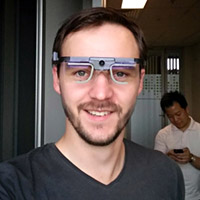PAX Australia, 27 October 2018
“Not just to win: The psychology of tabletop” Panel Discussion
A panel discussion on boardgames, featuring Melissa Rogerson (PhD student), an expert researcher on tabletop games.
Gaming often drives the early adoption of Natural User Interfaces (NUIs), and serves as a testing ground for their development. Technologies created for gaming, such as the Microsoft Xbox Kinect and the Tobii Eye Tracker 4C, enable new types of playful and immersive experiences — and often go on to impact wider society. However, while there is substantial research into the user experience of NUIs in work-like computer tasks, very little research has examined NUIs in the context of games and immersive environments. We believe that studying NUI in the game context is relevant to the use of these technologies, because the game experience can be quite different when immersed or embodied.
Research under this project generates knowledge about designing with NUIs in social games, through case studies that interrogate social play in games. The research agenda is multi-modal, and aims to contribute a rich understanding regarding the relationship between game embodiment, immersion and interface design.
In addition to academic articles, we communicate results in game industry and non-specialist publications, host talks at game conventions, demonstrate and exemplify our findings through videos, and develop game prototypes that demonstrate the foundations of our design guidelines.
Voice is widely used in social and competitive gameplay as a communication modality between players, where it has been shown to vastly improve player experience. However, as an input device for play, voice has a mixed status. It is often marginal and maligned due to the limitations of the technology, but sometimes fêted as a socially engaging way to play. In this project, we seek to understand the parameters of designing for voice interaction with game-like characters, through a study of existing practices and through the evaluation of for-purpose experimental games.
This project is led by Fraser Allison.
EyePlay research seeks to understand how gaze detection technologies can provide new and novel player and spectator experiences. This project examines the effects of gaze and how it can create social experiences in multiplayer games, through the exploration of its detection and display.
This project is led by Joshua Newn.
Tabletop gaming is a highly social situation due to the configuration of players and the social interactions afforded by tabletop game pieces. This project examines non-digital tabletop games and their digitisations to identify opportunities for NUI technologies to afford social play.
This project is led by Melissa Rogerson.
The sandbox-world builder game Minecraft is exceedingly popular, near ubiquitous in children between 8–12 and was recently purchased for $2billion dollars by Microsoft. This popularity, and its emphasis on creative world building, social interactions and cooperation have seen it adopted in schools and released as a standalone Minecraft for Education project. This project examines the social play of Minecraft and how it can support opportunities for social learning.
This project is led by PhD student Jane Mavoa, under the supervision of Martin Gibbs, Marcus Carter and Bjorn Nansen.
These projects were funded by the University of Melbourne’s Microsoft Research Centre for Social Natural User Interfaces (SocialNUI).









Allison, F., Carter, M., Gibbs, M. & Smith, W. (2018) Design Patterns for Voice Interaction in Games. In Proceedings of the Annual Symposium on Computer-Human Interaction in Play (CHI PLAY 2018), 28–31 October, Melbourne, Australia.
Rogerson, M., Gibbs, M., Carter, M. & Allison, F. (2018) Understanding Player Elimination in Boardgames as a form of Permadeath. In Proceedings of the 2018 Digital Games Research Association Conference (DiGRA 2018), 25–28 July, Turin, Italy.
Newn, J. (2018) Enabling Intent Recognition Through Gaze Awareness in User Interfaces. In Proceedings of the 2018 CHI Conference on Human Factors in Computing Systems – Doctoral Colloquium, May 2018, Montreal, Canada.
Newn, J., Allison, F., Velloso, E. & Vetere, F. (2018) Looks Can Be Deceiving: Using Gaze Visualisation to Predict and Mislead Opponents in Strategic Gameplay. In Proceedings of the 2018 CHI Conference on Human Factors in Computing Systems, May 2018, Montreal, Canada.
Rogerson, M., Gibbs, M. & Smith, W. (2018) Collaborating to Compete: the mutuality of cooperation and competition in boardgame play. In Proceedings of the 2018 CHI Conference on Human Factors in Computing Systems, May 2018, Montreal, Canada.
Miller, T., Singh, R., Newn, J., Sonenberg, L., Velloso, E. & Vetere, F. (2018) Combining Planning with Gaze for Online Human Intention Recognition. In Proceedings of the International Conference on Autonomous Agents and Multiagent Systems (AAMAS 2018), 10–15 July, Stockholm, Sweden.
Mavoa, J., Carter, M. & Gibbs, M. (2017) Children, digital games and Minecraft: a survey of young children’s gaming habits. New Media and Society DOI: 10.1177/1461444817745320
Allison, F., Carter, M. & Gibbs, M. (2017) Word Play: A History of Voice Interaction in Digital Games. Games and Culture DOI: 10.1177/1555412017746305
Mavoa, J., Carter, M. & Gibbs, M. (2017) Beyond Addiction: Parent perceptions of Minecraft play. In Proceedings of the Annual Symposium on Computer-Human Interaction in Play, 15nd 18 October 2017, Amsterdam, The Netherlands. DOI: 10.1145/3116595.3116638
Newn, J., Velloso, E., Allison, F., Abdelrahman, Y. & Vetere, F. (2017) Evaluating Real-Time Gaze Representations to Infer Intentions in Competitive Turn-Based Strategy Games. In Proceedings of the Annual Symposium on Computer-Human Interaction in Play, 15–18 October 2017, Amsterdam, The Netherlands. DOI: 10.1145/3116595.3116624
Rogerson, M., Gibbs, M. & Smith, W. (2017) What can we learn from eye tracking boardgame play? In Extended Abstracts Publication of the Annual Symposium on Computer-Human Interaction in Play, 15–18 October 2017, Amsterdam, The Netherlands. DOI: 10.1145/3130859.3131314
Rogerson, M., Gibbs, M. & Smith, W. (2017) Exploring the digital hinterland: Internet practices surrounding the pursuit of “offline” hobbies. Association of Internet Researchers Conference (AoIR 2017), 18–21 October 2017, Tart, Estonia.
Rogerson, M., Gibbs, M. & Smith, W. (2017) Using gaze data in understanding tabletop boardgame play. Games Research Methods Symposium, 10–11 July, Sydney, Australia.
Velloso, E. & Gellersen, H. (2017) Gaze Interaction Design: Eye Movement as a Design Material. Designing Interactive Systems Conference (DIS 2017), June 2017, Edinburgh, Scotland.
Mavoa, J., Gibbs, M. & Carter, M. (2017) Constructing the young child media user in Australia: a discourse analysis of Facebook comments. Journal of Children and Media, 11(3): 330-346. [DOI:10.1080/17482798.2017.1308400]
Carter, M. & Allison, F. (in press) Guilt in DayZ. In Transgressions in Games and Play, Eds. Jørgensen, K. & Karlsen, F., MIT Press.
Mavoa, J. (2017) The games children play: an analysis by title, gender and age. Extended Abstract presented at Digital Games Research Association Conference (DiGRA 2017), Melbourne, Australia.
Allison, F., Luger, E. & Hofmann, K. (2017) Player expectations of a learning AI companion in Minecraft. Extended Abstract presented at Digital Games Research Association Conference (DiGRA 2017), Melbourne, Australia.
Rogerson, R. & Cocks, J. (2017) F**king with psychology: psychological tests as boardgame design inspiration. Extended Abstract presented at Digital Games Research Association Conference (DiGRA 2017), Melbourne, Australia.
Rogerson, R., Gibbs, M. & Smith, W. (2017) Me and My Shelfie: hobbyists’ domestication of boardgames. Extended Abstract presented at Digital Games Research Association Conference (DiGRA 2017), Melbourne, Australia.
Carter, M. & Allison, F. (2017) Fear, Loss and Meaningful Play: Permadeath in DayZ. Journal of Gaming and Virtual Worlds 9(2):143–158
Velloso, E., Carter, M., Newn, J., Esteves, A., Clarke, C. & Gellersen, H. (2017) Motion Correlation: Selecting Objects by Matching their Movement ACM Transactions on Computer-Human Interaction (ToCHI) 24(3):article22. [DOI]
Allison, F., Luger, E. & Hofmann, K. (2017) Spontaneous Interactions with a Virtually Embodied Intelligent Assistant in Minecraft. In Proceedings of the 2017 CHI Conference Extended Abstracts on Human Factors in Computing Systems, Denver, USA. [DOI]
Allison, F. (2016) Are You Out of Your Mind? Focalization in Digital Games. Transactions of the Digital Games Research Association 2(3):31–60.
Carter, M., Fordyce, R., Gibbs, M., Robertson, N., & Witkowski, E., (2016) eSports Spectatorship in Australia. In Proceedings of the 2016 DiGRA Australia Conference, Melbourne [PDF]
Velloso, E. (2016) Game Controller Research from the Lab into the Wild: The Case of Eye Tracking. In Proceedings of the 2016 DiGRA Australia Conference, Melbourne [PDF]
Velloso, E. & Carter, M. (2016) The Emergence of EyePlay: A Survey of Eye Interaction in Games. In Proceedings of the 2016 Annual Symposium on Computer-Human Interaction in Play (CHI Play 2016). Austin, TX, USA [PDF]
Newn, J., Velloso, E., Carter, M. & Vetere, F. (2016). Exploring the Effects of Gaze Awareness on Multiplayer Gameplay. In Proceedings of the 2016 Annual Symposium Extended Abstracts on Computer-Human Interaction in Play (CHI PLAY 2016). Austin, TX, USA [DOI] [PDF]
Newn, J., Velloso, E., Carter, M. & Vetere, F. (2016). Dynamically Exposing Gaze to Foster Playful Experiences in Multiplayer Gameplay. In CHI PLAY 2016 Workshop on Designing for Emotional Complexity in Games: The Interplay of Positive and Negative Affect. Austin, TX, USA [PDF]
Newn, J., Velloso, E., Carter, M. & Vetere, F. (2016). Multimodal Segmentation of a Large Interactive Tabletop: Extending Interaction on Horizontal Surfaces with Gaze. In Proceedings of the 2016 ACM International Conference on Interactive Surfaces and Spaces (ISS 2016). Niagara Falls, ON, Canada [PDF]
Allison, F., Carter, M., & Gibbs, M. (2016). A History of Voice Interaction in Games. In Proceedings of the First Joint International Conference of DiGRA and FDG [PDF]
Rogerson, M. J., Gibbs, M., & Smith, W. (2016) "I Love All the Bits": The Materiality of Boardgames. In Proceedings of the 2016 CHI Conference on Human Factors in Computing Systems (CHI 2016), New York: ACM Press, pp. 3956–3969 [DOI]
Carter, M., Newn, J., Velloso, E., & Vetere, F. (2015) Remote Gaze and Gesture Tracking on the Microsoft Kinect: Investigating the Role of Feedback. In Proceedings of the Annual Meeting of the Australian Special Interest Group for Computer Human Interaction (OzCHI 2015) New York: ACM Press, pp. 167–176 [DOI]
Allison, F., Carter, M., & Gibbs, M. (2015). Good Frustrations: The Paradoxical Pleasure of Fearing Death in DayZ. In Proceedings of the Annual Meeting of the Australian Special Interest Group for Computer Human Interaction (OzCHI 2015) New York: ACM Press, pp. 119–123. [DOI]
Carter, M., Allison, F., Downs, J., & Gibbs, M. (2015). Player Identity Dissonance and Voice Interaction in Games. In Proceedings of the 2015 Annual Symposium on Computer-Human Interaction in Play (CHI Play 2015) New York: ACM Press, pp. 265–269 [DOI]
Rogerson, M. J., Gibbs, M., & Smith, W. (2015) Digitising Boardgames: Issues and Tensions, In Proceedings of the 2015 DiGRA International Conference. Lüneburg, Germany [PDF]
Carter, M., Nansen B., Gibbs, M. (2014) Screen Ecologies, Multi-Gaming and Designing for Different Registers of Engagement. In Proceedings of CHI Play, ACM Press, pp. 37–46. [PDF, DOI]
PAX Australia, 27 October 2018
A panel discussion on boardgames, featuring Melissa Rogerson (PhD student), an expert researcher on tabletop games.
Pursuit, February 2018
Article by Jane Mavoa (PhD student).
Education Review, February 2018
Article by Jane Mavoa (PhD student).
ABC Radio Melbourne, 18 April 2018
interview with Melissa Rogerson (PhD student) on her research into competition and cooperation in boardgames.
RoyalAuto Magazine, May 2018
Australia’s highest-circulating magazine features Melissa Rogerson (PhD student).
Parenting for a Digital Future, 18 April 2018
Blog post published by The London School of Economics and Political Science, Parenting for a Digital Future publication. Article by Jane Mavoa (PhD student).
The Conversation, 17 January 2018
By Jane Mavoa and Marcus Carter
RN Drive, with Patricia Karvelas, 25 January 2018
Radio 2SER, Sydney, January 2018
An interview with PhD student Jane Mavoa
Mamamia, 22 January 2018
Interview with Helen Vnuk.
ABC News, 22 December 2017
News article includes interview with PhD student Fraser Allison
ABC Radio Sydney, 27 December 2017
ABC Radio Summer Afternoons (national broadcast), 11 January 2018
ABC Radio Darwin’s Drive, 9 January 2018
Channel 9 News, 25 January 2018
ABC Radio Adelaide, 22 December 2017
The Conversation, 24 January 2017
An article by Fraser Allison.
Pursuit, 13 October 2016
The reality TV show Survivor is a phenomenon where betrayal and social skills are central to what is more a sport than a game show. An article by Dr Marcus Carter.
Pursuit, 23 August 2016
Pursuit article by SocialNUI Resesarcher, Eduardo Velloso.
The Conversation, 13 July 2016
The Conversation, 12 July 2016
12 July 2016
The Conversation, 11 July 2016
The Conversation, 29 March 2016
Gamasutra, 23 March 2015
The Age, 7 January 2015